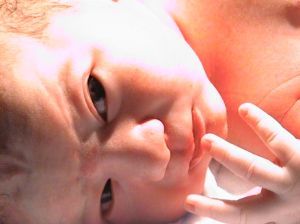This article will outline some of the risks of elective c-section. While the risks are the same with a c-section you didn’t choose, it is important to understand that it you elect to have a c-section, you are signing up for a potential host of problems.
I don’t mean for this article to judge. I mean for it to inform. Please take that into account if you disagree with my views. I have interviewed several women who’ve had c-sections to get this information, as well as reading studies and accounts from other women.
No matter what you decide to do at the end of your pregnancy, I hope the best for you and your baby.
Risks of Elective C-Section
Longer Recovery:
While it takes about 6 weeks to recover from a vaginal childbirth, it can take 6 months or longer to recover from a c-section. Pain, weakness, and bloating can persist for a year or more, though not typically at the levels you experience right after your c-section.
This causes many other potential complications. Some of those complications are:
Inability to bond with your baby:
Because the ‘natural’ process is interrupted and you are busy being attended to after your child’s birth, some mothers have stated they found it difficult to bond with their baby. Others have expressed frustration with the experience or with their bodies for taking the natural process away from them. This can lead to or contribute to worsening of post-partum depression, a potentially serious mental health issue affecting 10% or more of women who have recently had a baby.
Difficulty breastfeeding:
Having a c-section can make breastfeeding more difficult, because of the location of the incision and the fact that nursing causes uterine contractions after birth to get the uterus back to near pre-pregnancy size. There are other nursing positions that are easier on a mother after she’s had a c-section, but sometimes it is difficult to get the baby to nurse in these positions, either due to baby’s aversion to the position, awkwardness of the position, or inexperience of the mother with nursing.
Atop that, the drugs that you may have gotten during labor and delivery can affect the nursing relationship, causing the baby to be groggy or leading to latch issues.
Difficulty caring for your baby:
Let’s face it, recovering from abdominal surgery is hard. So is having a new baby. Combine the two and you’ll be downright exhausted. Many new mothers complain that they feel like a zombie for months after the birth of their baby due to lack of sleep and the constant ups and downs to get the things they need to care for their baby. Babies also want to be held, sometimes for large parts of the day. This can be difficult if you’re trying to avoid pressure on your incision. Getting up and down to get the things your baby needs, lifting your baby, bathing your baby, and other activities can be made more difficult if you are also recovering from surgery.
There are also other risks when you’re considering a c-section that need to be taken into account.
Some of those risks are:
Bleeding:
Trauma to the uterus can keep it from contracting normally, leading to hemorrhage or abnormal bleeding.
Infection:
There is always a risk of infection when surgery is performed. Post-partum women are also at risk of developing infections due to the large, open wound in their uterus. Infections in incisions can lead to unsightly scars or worse.
Cuts on baby:
There is always a minor risk that your baby can be cut during a c-section.
Loss of infant/mother:
The risk to mother and baby is higher if the baby has to be removed by c-section. Since it is not a natural procedure, but invasive surgery, it carries a mortality risk.
Another point of contention regarding c-sections is that many hospitals are now refusing to allow women who’ve had a c-section to try for a vaginal birth with any subsequent children due to risk of liability and potential costs. If you elect to have a c-section, you may never get the opportunity to try a vaginal birth with your next child/ren due to hospital policy. You may think that’s not a big deal, but if you decide later that the c-section wasn’t what you would have wanted for yourself, you can’t go back and try again with your next child unless you are able to find a hospital, birth center, or homebirth midwife who will attend you during a vaginal delivery after having a c-section.
It is important to note that while some hospitals still allow women to attempt VBAC (vaginal birth after cesarean), the national trend is moving away from allowing women this option, even in large, well staffed hospitals. What may be an option now may be taken away from you 2 or 3 years down the road.
As always, it is important to know the risks of any procedure that you or your doctor are considering. A ‘healthy baby’ isn’t all that matters. You, your body, and your rights matter as well. You are not just a pod for your baby, and if your rights are stripped from you, it can lead to complications in the future to your physical or emotional health.
I wish everyone a happy birth.



